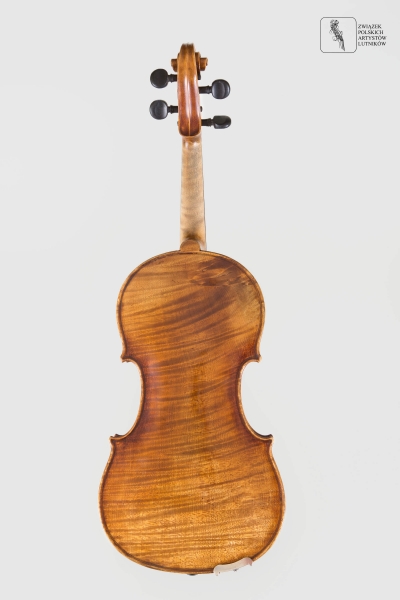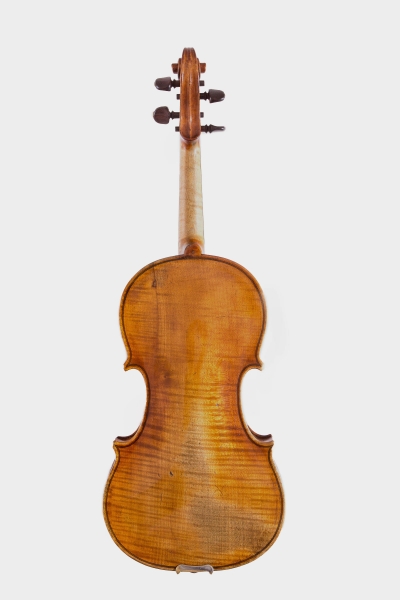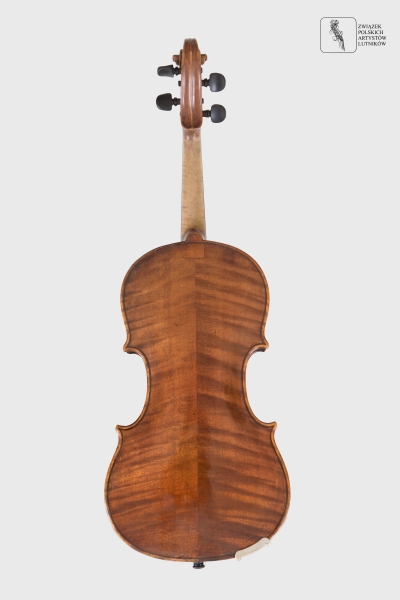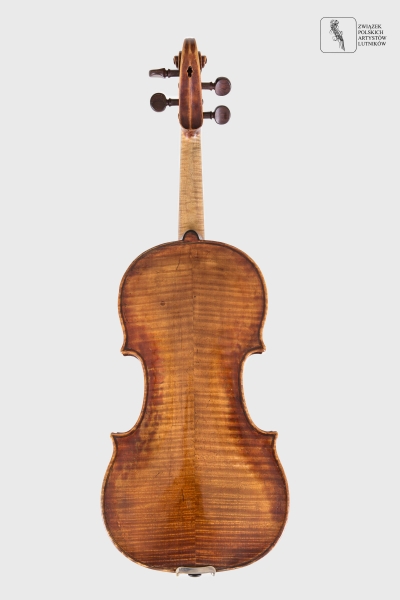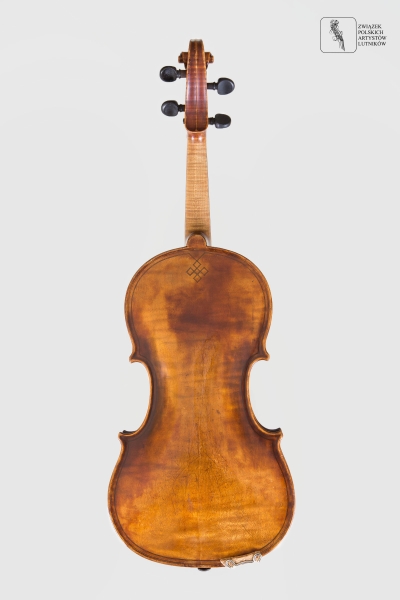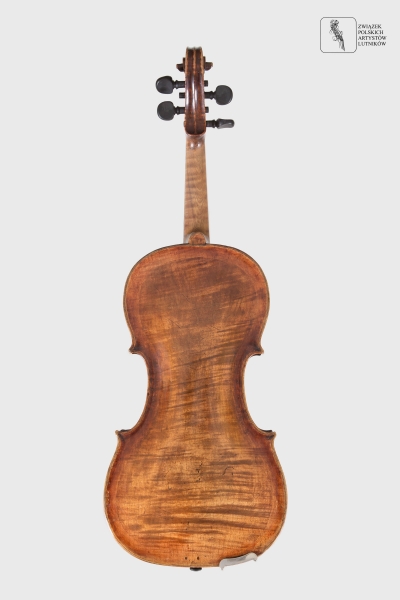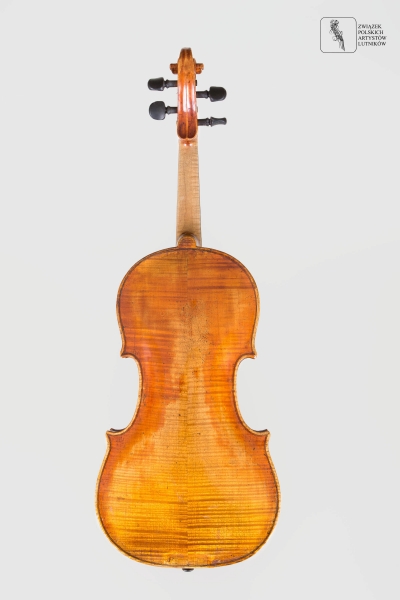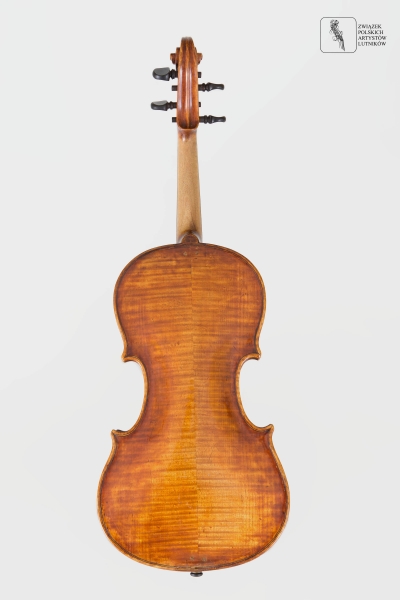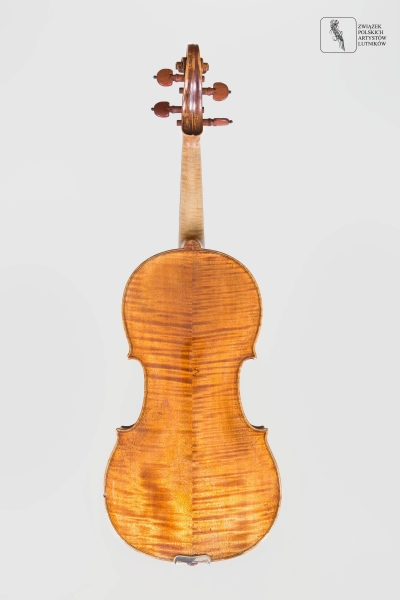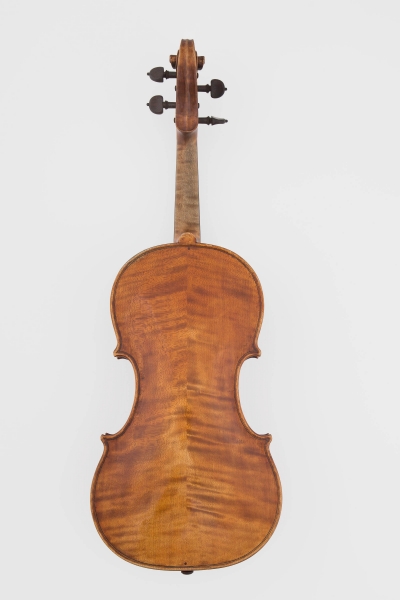International Henryk Wieniawski Violin Competitions
One interesting way to look at the history of the International Henryk Wieniawski Violin Competition is through the succession of instruments played by Polish prizewinners of the contest. The violins came from different sources: the Collection of Violins of the Polish Ministry of Culture and National Heritage administered by the Polish Union of Artist Violin Makers, private collections, foreign foundations such as the Järnåkerfoundation or the Albert-Eckstein-Stiftung, the Musical Instrument Museum in Poznań, the Grażyna and Kiejstut Bacewicz Academy of Music in Łódź, and the Henryk Wieniawski School of Music in Łódź. To learn more about the instruments described in the overview below, browse our online collection by object or name.
1935
The International Henryk Wieniawski Violin Competition goes back to 1935, the year that marked the 100th birth anniversary of its patron and one of the world's most prominent violinists. The idea came from Henryk's nephew, Adam Wieniawski, a composer, educator, director of the Warsaw Musical Society, and experienced organiser of two editions of the International Fryderyk Chopin Piano Competition in Warsaw. From its inception, the Wieniawski competition has been, alongside the Chopin contest, Poland's key music event. Held in Warsaw, the first edition was an instant success: 160 candidates from 23 countries applied to take part, and 55 violinists from 16 countries were accepted into the first round. Professor Adam Wieniawski chaired the jury. The highly talented prizewinners – 15-year-old Ginette Neveu (first prize), Dawid Ojstrach (second prize), and seven-year-old Ida Haendel (seventh prize; highest ranking Pole in the competition) – brought the event fame and prestige. Among the contestants was Grażyna Bacewicz (honorary diploma), who later became the competition's juror1. Winners of the first two prizes received instruments made by prominent Polish luthier Tomasz Panufnik (father of composer Andrzej Panufnik). Ms Neveu received a Polonia violin characteristic for its beautiful, curvy, ornamental shape with a female head in place of the scroll, while Mr Ojstrach was gifted Panufnik's classically-shaped Antica model2. The event was scheduled to repeat every five years, yet the second world war foiled the plan.
1952
The second edition of the International Henryk Wieniawski Violin Competition was held 17 years later, in 1952. Thoroughly devastated during the second wold war, Warsaw was still in the process of rebuilding. The capital had no appropriate concert venue. The decision was made to relocate the competition to Poznań, which was a positive influence on both the city's and the event's development. Although – as time passed – attempts were made to move the competition back to Warsaw, today it still takes place at an auditorium of the Adam Mickiewicz University in Poznań3. Soon two other competitions were launched in Poznań, also bearing the name of Henryk Wieniawski: the International Composing Competition (1956–1990) and the International Violin Making Competition (since 1957 onwards).
The programme required of the participants of the second edition of the Wieniawski violin competition was had been considerably expanded as compared to the first edition, with particular emphasis being put on Polish music, including contemporary composers. While the first edition resounded with Wieniawski music, the second featured works by Karol Lipiński, Karol Szymanowski, Aleksander Zarzycki and selected pieces by Grażyna Bacewicz, Artur Malawski, Roman Statkowski, and Stanisław Wiechowicz. As well as Wieniawski's concertos, participants of the second stage played compositions by Mieczysław Karłowicz and Karol Szymanowski.
The political situation in Poland after the second world war, what with the establishment of the communist rule, contributed to decreased interest in the 1952 edition of the competition and made it harder for foreign violinists, musicologists, and critics to come to Poznań. Passports were more difficult to obtain, while the Polish foreign ministry informed that "the capitalist countries refuse to take part in the competition". In the end, only 40 candidates applied, 23 of which – representing 8 countries – qualified to take part. The jury was almost entirely made up of representatives of the "people's democracies". It was chaired by Tadeusz Szeligowski. First prize went to Igor Oistrakh (USSR), while second prizes were awarded to Wanda Wiłkomirska (Poland) and Julian Sitkovetsky (USSR), whose subsequent stellar careers fully confirmed their phenomenal talents4. The second Wieniawski violin competition is also one of few whose records have survived to this day and provide account of almost all violins played by the candidates5. Igor Oistrakh played a 1679 violin made by Andreas Guarnerius in Cremona, while Poland's phenomenal violinist Wanda Wiłkomirska played an instrument by an unknown luthier made after Guarneri del Gesù. Today held in the Collection of Violins of the Polish Ministry of Culture and National Heritage (KIL-1), according to an attached note, the violin was repaired by Józef Rymwid-Mickiewicz and had been used by Wiłkomirska for 33 years, although it is possible that she replaced it with a different model at the end of the 1952 competition. Julian Sitkowiecki played a 1799 instrument by Vincenzo Panormo made in Palermo6. Other master violins also appeared in the competition yet the musicians who played them were less lucky. Wiłkomirska was also granted the award for the best Polish violinist, receiving a violin made by Józef Świrek after Stradivari's Greffuhle model7. Extant minutes of the jury's meetings testify to the grim realities of post-war Poland, which affected the teaching of music, the interest in violin playing and the competition: "The network of music schools is wide, yet it is hard to convince students to take up the violin. Most choose the piano or voice; in the country, the accordion is very popular. There are two reasons for that: parents' aversion to the violin (the piano is deeply rooted in the tradition) and lack of teachers. Many educators lack qualifications and are unable to make students interested in violin playing. Another setback is the lack of smaller-sized violins (halves and quarters)…"8. With time the difficulties were overcome and more and more young Polish violinists would compete, and succeed, at national and international violin competitions. Since its first post-war edition, the Wieniawski competition has been supported by the family of Poznań-based luthiers, Stefan and Benedykt Niewczyk9.
1957
The third Wieniawski violin competition was held in 1957, at a special time after the October of 1956, which brought about a more liberal shift in Polish politics. Among the participants and members of the jury there were many representatives of the Western world, with Yehudi Menuhin (USA) acting as the honorary chair of the jury. Instead of two, three stages were held. The second one featured 45 recitals with piano. The programme of the third was expanded to include concertos by Grażyna Bacewicz and Zbigniew Turski, in line with the strategy to promote contemporary Polish music. Bacewicz was the chair of the jury. The third Wieniawski violin competition saw 45 participants from 15 countries. First prize went to Roza Fain (USSR), yet it it was the second-prize winner and the audience's favourite, Sidney Harth of the USA who, in the end, turned out to be the hotter name. (He had not participated in the second edition because he did not get the Polish visa.)10
1962
With the post-war upheavals over, Wieniawski competitions were held regularly every five years. The interest in them was, nevertheless, decreasing. This was reflected, for instance, in the number of violinists taking part in the event. The fourth edition in 1962 gathered 24 participants representing nine countries. The jury was chaired by Zdzisław Górzyński11. First prize went unequivocally to the USA's Charles Treger. The best Pole was Krzysztof Jakowicz (third prize), who shot to fame soon after. He played a violin made in the workshop of excellent Czech luthier Přemysl Otakar Špidlen in Prage (KIL-35) and awarded first prize in the 2nd International Henryk Wieniawski Violin Making Competition held in the same year. One of the honourable mentions went to Jadwiga Kaliszewska, who subsequently spent long years working for the competition as an educator, juror and organiser. In 1962 she played an extraordinary instrument – a beautiful, opulently decorated violin attributed to Baltazar Dankwart (MNP I 235).
1967
Held in 1967, the fifth competition was judged by a jury chaired by Grażyna Bacewicz and included Henryk Szeryng (then a citizen of Mexico), veteran juror Irena Dubiska (Poland), Eugenia Umińska (Poland), and Tadeusz Wroński (Poland). The participants were required to play a Wieniawski concerto with piano accompaniment already in the first stage. The obligatory programme also included Paganini's caprices. The jury had to choose between 21 violinists from six countries12. For the first time in history first prize was awarded to a Pole, 16-year-old Piotr Janowski, a student of the prominent violinist Irena Dubiska, playing a violin attributed to Pietro (III) Guarneri (KIL-41). Third prize also went to a Pole, Kaja Danczowska, who played a copy of Amati's violin (KIL-13). Maria Brylanka (later: Brylanka-Liebig), playing a 19th-century violin created at Sebastien Vuillaume's Paris-based workshop, received an honourable mention.
1972
The sixth competition saw the number of contestants decreasing significantly: only 39 violinists from 11 countries took part. The jury was chaired by Irena Dubiska. Wieniawski concertos were no longer the required repertoire in the first stage; the programme of the third round was extended to include violin concertos by Beethoven, Brahms, and Prokofiev. Japanese violinists entered the competition for they first time, not without instant success. Top three prizes were awarded to women: Tatiana Grindenko (USSR; wife to well-known violinist Gidon Kremer), Shizuka Ishikawa (Japan), and Barbara Górzyńska (Poland), respectively13. The Pole played a violin made by Giovanni Dolling, which then belonged to the Wieniawski Musical Society of Poznań. Fifth prize went to Tadeusz Gadzina, playing a violin made at the Paris-based workshop of Jean-Baptiste Vuillaume.
1977
The seventh competition opened with a concert by Igor Oistrakh, who himself admitted that winning the Wieniawski competition 25 years before had been his first international success. In 1977 the jury was again headed by Irena Dubiska, with Oistrakh acting as one of the deputy chairmen. The panel also included recent prize-winner Krzysztof Jakowicz. The Organisational Committee was led by Andrzej Wituski, the then deputy mayor of Poznań, who has remained involved with the event to this day. Competing for the top prizes were 46 contestants from 16 countries. The race was very close. In the end, the highest accolade was awarded to Vadim Brodsky (USSR), second prizes went to Piotr Milewski (Poland) and Mikhail Vaiman (USSR), while Zakhar Bron (USSR) and Peter A. Zazofsky (USA) took third prizes14. Mr Milewski played an Italian instrument made by Giovanni Dollenz, the same Barbara Górzyńska used in the previous edition of the competition. Third prize and the Wanda Wiłkomirska Award for the best female contestant was given to Anna Aleksandra Wódka (now Wódka-Janikowska), playing a violin built in 1748 in Naples by Gennaro (Januario) Gagliano.
1981
Unusually, the eight competition was held in 1981, four not five years after the previous edition, which was fortunate as the martial law declared in Poland in December 1981 and lasting until 1983 would have undoubtedly jeopardised the event. The competition opened with a concert by Henryk Szeryng, phenomenal Polish violinist and head of the 1981 jury. The panel included Wanda Wiłkomirska and Konstanty Andrzej Kulka for the first time. Taking part were 24 violinists representing nine countries. Five of six prizes were awarded to the Japanese, with Keiko Urushihara coming first, Elisa Kawaguti second, and Aureli Błaszczok of Poland third15. One of the honourable mentions was awarded to Bartosz Bryła, playing a violin attributed to Nicolas Lupot and belonging to Jadwiga Kaliszewska at that time. Another honorary mention was given to Magdalena Suchecka, who played an instrument presumably made by a Tyrollean luthier in the late 19th century, which had a chequered past: the top had been shattered when its owners had been fleeing from the war in 1939 and restored afterwards.
1986
The 9th International Henryk Wieniawski Violin Competition marked 50 years of its existence and 100 years of the Henryk Wieniawski Musical Society. The 1986 jury was chaired by Stanisław Wisłocki (who had taken part in the opening of the 1952 competition as conductor). A special guest on the panel was Ida Haendel, who had participated in the first competition in 1935 and was the youngest winner in the event's history. The jury faced the task of choosing from 45 candidates representing 18 countries16. The lucky winner was Evgeny Bushkov (USSR), while Robert Kabara (Poland) ranked third. The Pole played a 18th-century violin attributed to Pietro (III) Guarneri (KIL-41). Dorota Siuda of Poland received an honourable mention. She played a 1982 instrument which she commissioned from Władysław Gąsienica "Makowski" in Kraków and helped build.
1991
The subsequent edition of the competition was held in 1991, following the fall of communism in 1989. With the political transformation came changes in the event's organisation, including new technical possibilities. A biographical film about Henryk Wieniawski was made, cassettes were recorded, and the whole competition was captured on tape for the first time. The event attracted greater interest than before: 54 violinists came down to Poznań from 15 countries around the globe. In the end, the competition was down to Poles and the Japanese17. Headed by Stanisław Wisłocki, the jury named two winners: Bartłomiej Nizioł (Poland), playing a Pietro [III] Guarneri instrument loaned by the ministry of culture's collection of violins, and Piotr Pławner (Poland), who used a 19th-century violin by an unknown French or German luthier rented from the Henryk Wieniawski School of Music in Łódź. Second and third prize went, respectively, to Chie Abiko and Reiko Shiraishi, both representing Japan. Placing fourth was Monika Jarecka (now Uhler), who played a copy of Amati violin previously used by Kaja Danczowska for 13 years (KIL-13). Honourable mentions were awarded, among others to, Jarosław Żołnierczyk, who played a violin attributed to G.B. Guadagnini (KIL-5) and Ewa Pyrek, playing a 1927 instrument made in Feliks Konstanty Pruszak's atelier and lent by Professor Tadeusz Wroński, who in turn had bought the excellent instrument when still a student of Józef Jarzębski. Wroński held on to the violin his whole life; currently, it is played by Krzysztof Jakowicz (e.g. on the album Skrzypce z polską duszą). Another honourable mention went to Roland Orlik, who played a contemporary Polish violin made in 1990 in the workshop of Tadeusz Wojciech Kmiecik.
1996
The jury of the 9th International Henryk Wieniawski Violin Competition (1996) had Karol Stryja as its chairman and Sir Yehudi Menuhin as its honorary chairman. Also in attendance were descendants of Henryk Wieniawski – his great-granddaughter Anita Munroe (descended from Wieniawski's daughter Izabela) and great-grandson Robin Patteson Knight (descended from his daughter Henrieta), who gifted to the Wieniawski Musical Society some valuable family memorabilia. Out of 105 applicants, 53 violinists qualified to take part in the competitions, and 38 took on the challenge. Unfortunately, for the first time in the event's history, first prize was not awarded. Emerging as winners of the second, third and fourth prizes were Japanese violinists Reiko Otani, Akiko Tanaka, and Asuka Sezaki, respectively18. Also awarded fourth prize was Łukasz Błaszczyk (Poland), who played an instrument made by Polish luthier Jan Pawlikowski, while fifth prize went to Anna Reszniak, playing a violin dating to ca. 1800, attributed to France's Nicolas Lupotow, and once owned by Jadwiga Kaliszewska. Maria Małgorzata Nowak won sixth prize, playing an instrument built in Bernardo Calcagni's atelier and rented from a Berlin conservatoire. Honourable mentions were awarded to a pair of Poles: Erika Dobosiewicz and Andrzej Hop. The latter's instrument was a 1990 violin by American luthier Douglas Cox.
2001
With the twelfth edition, the competition entered the new millennium. At the helm in 2001 was Shlomo Mintz, who played a key role in organising the event, chaired the jury, and single-handedly chose participants of the first stage. The twelfth Wieniawski competition was the first to attract extensive media attention. The event was covered on Polish Radio 2 and Radio Bis; it had a website, which reported 113 thousand views in the course of the event; the developments were also reported in a daily issue of Głos Konkursowy (The Competition Voice). What is more, a film tracking the competition's history was released on DVD for the first time. All participants of the first stage were required to perform Krzysztof Meyer's Capriccio interrotto, commissioned especially for the occasion. In the third stage candidates could choose to play one of Wieniawski's concertos or a concert version of one of his polonaises. The competition saw 46 candidates from 16 countries. On display, apart from their skills, was an exhibition devoted to Antonio Stradivari's genius work. The winner of the 2001 edition was Alena Baeva of Russia19. Three years later when she won the 2004 Niccolo Paganini competition in Moscow, she was given a year-long use of a 1723 Stradivari violin once owned by Henryk Wieniawski20. Among the Polish prizewinners was Jarosław Nadrzycki (fifth prize), who payed a violin after a Guarneriego del Gesù model which had been previously used by Wanda Wiłkomirska for many years (KIL-1). Five years later Mr Nadrzycki won fifth prize at the subsequent Wieniawski competition, playing the very same instrument. Among the recipients of honourable mentions were Mariusz Morys, playing an instrument belonging to luthier Marek Pielaszek, and Jakub Haufa, who used the already mentioned violin attributed to Nicolas Lupotow.
2006
The thirteenth Wieniawski competition held was led by one of Poland's most exquisite violinists, Konstanty Andrzej Kulka, who prior to becoming the chairman of the 2006 jury had never participated in the contest. Kulka introduced another set of changes into the programme, reinstating Wieniawski works into every stage of the rivalry. He was also personally in charge of selecting participants of the first stage. As 2006 saw a significant number of violin competitions taking place, many candidates withdrew from the Poznań event. In the end, only 32 violinists entered the contest21. The highest accolade was awarded to Agata Szymczewska, playing a 18th-century instrument by Vincenzo Panormo. Placing second was Airi Suzuki (Japan). Third prize was awarded to Anna Maria Staśkiewicz (Poland), playing a C.A. Testore violin (KIL-6). Fifth prize went to Maria Machowska (Poland), who used a violin made by Józef Bartoszek in Zakopane in 1992, belonging to Mirosław Ławrynowicz. Jarosław Nadrzycki enetered the competition again, and again won fifth prize, playing the same violin after Guarneri del Gesù as before. Wojciech Pławner, Piotr’s brother, received sixth prize, playing an instrument by Italian luthier Francesco Lazaretto made in 1893 in Vicenza. The closing ceremony featured a performance by Maxim Vengerov accompanied by the Sinfonia Varsovia orchestra. The world-famous violinist’s first appearance in Poznań was an overture to the next instalment of the violin playing rivalry.
2011
In 2011 Maxim Vengerov took over as the chairman of the jury of the fourteenth Wieniawski violin competition, while Ida Haendel was appointed the honourable chairwoman. As in previous years, in his capacity as the chairman of the jury, Vengerov personally handpicked participants of the competition. Unlike before, preselection auditions were held in Poznań as well as eight cities throughout the world. The programme was changed to include a performance with a chamber orchestra. Korea's Soyoung Yoon emerged as the winner. She played a 1773 J.B. Guadagnini ex Bückeburg violin22. One of the many special awards, the Florian Leonhard Award, which consisted in being granted a year-long use of a 1779 Turin-made Giovanni Battista Guadagnini violin, was given to Erzhan Kulibaev of Kazachstan23. Polish violinists did not win any of the competition prizes or honourable mentions, yet – to their credit – they received many of the special awards, including Aleksandra Kuls, who played a copy of Pietro (III) Guarneri instrument from the ministerial Collection of Violins24. Many of the Polish participants claimed to have violins by contemporary Polish luthiers, including Tadeusz Słodyczka, Józef Świrek, Honorata Stalmierska, Wojciech Topa, and Andrzej Pancerz25. Staring with this edition, the Institute of Music and Dance based in Warsaw became the competition's co-organiser, contributing towards the cost of the event with funds earmarked for the purpose by the Polish ministry of culture.
2016
Maxim Vengerov continued as the chairman of the next Wieniawski competition in 2016 26. A significant and welcome change as compared to previous editions was the event's extensive coverage in the media, including live broadcasts of the concerts and auditions with expert commentary on TVP Kultura, Poland's national television broadcaster's culture channel, on Polish Radio 2, and online. The Fryderyk Chopin Institute in Warsaw and the Henryk Wieniawski Musical Society developed an application enabling users to follow all events of the competition and explore its history. Often, before a candidate entered the stage, the audience and jury were informed what instrument the contestant was about to play, just as it is the practice during the Chopin competitions to announce what piano the upcoming participant has chosen. Such attempts to draw attention to the instruments should be appreciated. Hopefully, more and more people develop an interest in the work of luthiers, including Polish ones, both those of the past and those of the present.
Joanna Gul
1. E. Grabkowski, Henryk Wieniawski, Warszawa 1985, pp. 125–126; Da capo: 75 Years of International Henryk Wieniawski Competitions, ed. R. Połczyński, Henryk Wieniawski Musical Society, Poznań 2011, pp. 12–25.
2. Beniamin Vogel, Słownik lutników działających na historycznych i obecnych ziemiach polskich oraz lutników polskich działających za granicą do 1959 roku, Szczecin 2007.
3. Da capo: 75 Years…, loc. cit.
4. Ibid., pp. 28–30.
5. N. Karaśkiewicz, Międzynarodowe Konkursy Skrzypcowe imienia Henryka Wieniawskiego 1935, 1952, 1957, Poznań 1962. The book provides information on luthier labels of numerous instruments played by the participants of the 2nd International Henryk Wieniawski Violin Competition. Information on instruments played by prizewinners of subsequent competitions, both private and held in the ministerial Collection of Violins, provided in the text has been gathered by A. Mierzejewska based on unpublished records and archives of the Polish Union of Artist Violin Makers.
6. Ibid., pp. 35, 39.
7. B. Vogel, op. cit.
8. Minutes of the deliberations of the jury of the 2nd International Henryk Wieniawski Violin Competition, ref. no. II MKS/12, Archives of the the Henryk Wieniawski Musical Society of Poznań.
9. Da capo: 75 Years..., p. 169.
10. Ibid., pp. 42–50.
11. Ibid., pp. 52–62.
12. Ibid., pp. 63–76.
13. Ibid., pp. 77–88.
14. Ibid., pp. 89–100.
15. Ibid., pp. 101–114.
16. Ibid., pp. 115–126.
17. Ibid., pp. 127–140.
18. Ibid., pp. 141–152.
19. Ibid., pp. 153–170.
20. Website of the Henryk Wieniawski Musical Society of Poznań <http://www.wieniawski.com/baeva_alena.html> accessed Oct. 2016.
21. Da capo: 75 Years…, pp. 171–190.
22. The 14th International Henryk Wieniawski Violin Competition [competition catalogue], Henryk Wieniawski Musical Society in Poznań, Poznań 2011, online facsimile <http://www.wieniawski.com/competition-catalogue.html>, accessed Oct. 2016, p. 127.
23. The 14th International, p. 38.
24. The 14th International…, p. 95.
25. The 14th International…, pp. 77, 80, 98, 105, 109, 122.
26. Website of the Henryk Wieniawski Musical Society of Poznań <http://www.wieniawski.pl> accessed Oct. 2016.
